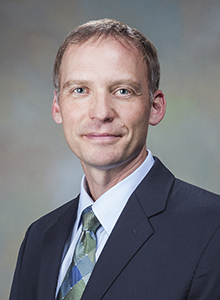Materials society names Sandia’s Don Susan Fellow

Don Susan, a researcher in Sandia’s Metallurgy and Materials Joining Dept. 1831, has been named a Fellow of ASM International in recognition of distinguished contributions to materials science and engineering.
The society’s citation says Don received the honor, one of the highest in the field of materials, for "sustained contributions in the areas of physical metallurgy and joining research, materials characterization, and failure analysis."
The 22 members of ASM’s 2016 class of Fellows will be honored at the society’s annual awards dinner Oct. 25 in Salt Lake City during the Materials Science & Technology 2016 conference.
“It’s a big honor for me, especially knowing the Fellows who came before me,” Don says. “It’s a big honor to follow in their footsteps.”
Don, who joined Sandia in 2000, says the award recognizes a broad range of work during his career. His areas of expertise include hermetic connector technology, tin-lead and lead-free solder metallurgy, active brazing alloys, electrical contact alloy metallurgy, high-strength stainless steels, metallography and quantitative image analysis, and failure analysis. He is a co-inventor on work that led to a patent on glass-ceramic to metal sealing for high-temperature, high-pressure applications.
“I have a lot of interests and I’m glad to be recognized by ASM as a generalist in metallurgy,” he says.
Interest in materials science came from dad
When Don was young, his father worked in a Honeywell facility that made plastic film, and “I guess the materials science aspect rubbed off on me, except it was metals, not polymers,” says Don, who holds a doctorate in materials science and engineering from Lehigh University.
He also has worked on shape-changing alloys and was principal investigator for a three-year project to create high-temperature shape-memory alloys. In addition, over the years he worked on numerous teams conducting materials research and component evaluations to ensure the safety, security, and reliability of the nation’s nuclear weapons stockpile.
Don recalls a project on an iron-cobalt based alloy called Hiperco that turned out to be satisfying for him and his colleagues because they solved a problem in an unexpected way.
Hiperco had poor mechanical properties, but the team found a way to increase its strength by two to three times through a process called Equal Channel Angular Extrusion, which extrudes a bar of metal in a way that can be described as going around a corner. “We were all skeptical at first, but it works,” Don says. “This was a very satisfying project because it was a bit of a surprise to all of us.”
Fellows serve as advisers to ASM International to enhance its standing as a leading organization for materials and provide a resource to serve the worldwide community of materials scientists and engineers in the years ahead. The society established the honor in 1969 to recognize Fellows’ contributions and to develop a broadly based forum of technical and professional leaders to be advisers.
ASM International was founded in 1913 as the American Society for Metals. Today, it has more than 30,000 members worldwide and is the world’s largest association of metals-centric materials scientists and engineers.